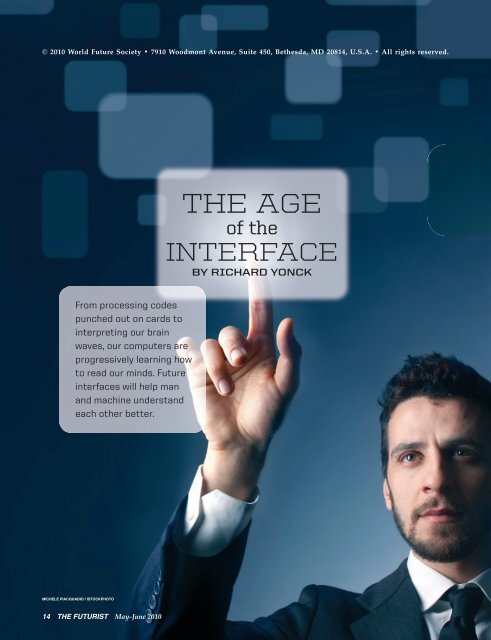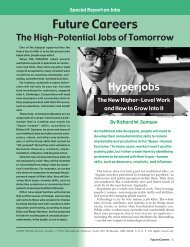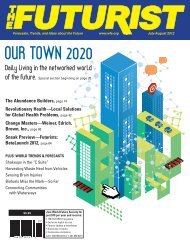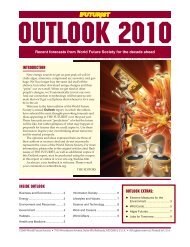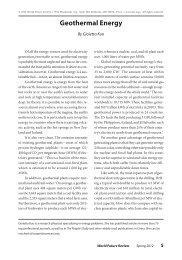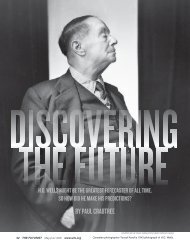THE AGE - World Future Society
THE AGE - World Future Society
THE AGE - World Future Society
You also want an ePaper? Increase the reach of your titles
YUMPU automatically turns print PDFs into web optimized ePapers that Google loves.
© 2010 <strong>World</strong> <strong>Future</strong> <strong>Society</strong> • 7910 Woodmont Avenue, Suite 450, Bethesda, MD 20814, U.S.A. • All rights reserved.<br />
<strong>THE</strong> <strong>AGE</strong><br />
of the<br />
INTERFACE<br />
BY RICHARD YONCK<br />
From processing codes<br />
punched out on cards to<br />
interpreting our brain<br />
waves, our computers are<br />
progressively learning how<br />
to read our minds. <strong>Future</strong><br />
interfaces will help man<br />
and machine understand<br />
each other better.<br />
MICHELE PIACQUADIO / ISTOCKPHOTO<br />
14 <strong>THE</strong> FUTURIST May-June 2010
E<br />
ver since we humans started<br />
building levers, wheels, and<br />
other tools, we’ve needed<br />
ways to interface with them — that<br />
is, to operate and control them. Initially<br />
the means of operating our devices<br />
were direct and highly intuitive.<br />
But as our machines grew in<br />
complexity over time, the controls<br />
became increasingly complex and<br />
more abstracted from the processes<br />
they managed.<br />
The word interface is defined as a<br />
connection between systems, equipment,<br />
or people. It’s most commonly<br />
associated with computing, but it is<br />
applicable to practically any human–<br />
machine activity. Interfaces exist to<br />
facilitate interaction. As Apple Computer<br />
put it, “The less alike two entities<br />
are, the more obvious the need<br />
for a well-designed interface becomes.”<br />
A properly designed and implemented<br />
interface not only facilitates<br />
system-to-system communication,<br />
but it also simplifies and automates<br />
control of otherwise complex functions.<br />
Interfaces let us operate on<br />
things that we can’t otherwise deal<br />
with and peer into regions where we<br />
couldn’t otherwise see. From steering<br />
aircraft carriers to moving atoms<br />
with atomic force microscopes, interfaces<br />
rescale our actions. They translate<br />
digital signals and invisible radiation<br />
into media that are readily<br />
accessible to our senses. In essence,<br />
they become our eyes, ears, hands,<br />
and even extensions of our minds.<br />
As astounding and varied as our<br />
interfaces are today, they’re on track<br />
to become much more so in the near<br />
future. Under development now are<br />
a range of new methods for interacting<br />
with our devices in ways that<br />
would have been inconceivable only<br />
a few years ago. With so many advances<br />
now on the horizon, we may<br />
someday look back on this period as<br />
the Golden Age of the Interface.<br />
FORCES ACCELERATING<br />
INTERFACE DEVELOPMENT<br />
Several factors are driving this<br />
wave of innovation. Continuous improvement<br />
in computing plays a particularly<br />
critical role. As microprocessors<br />
become faster and more<br />
Subvocal interface: When there is too much background noise to have a<br />
cell-phone conversation, you might opt for a subvocal speech-recognition<br />
system, as shown by NASA researcher Chuck Jorgensen. The system reads<br />
nerve signals in the user’s throat and relays them to a remote computer that<br />
translates them into words.<br />
powerful, there are more processing<br />
cycles to spare. This allows for designs<br />
that are more intuitive and<br />
user-friendly — for instance, by incorporating<br />
artificial intelligence to<br />
better anticipate user intentions. At<br />
the same time, circuits are shrinking<br />
in scale, allowing devices to be configured<br />
and located in ways they<br />
never could be before.<br />
Smaller devices also need different<br />
input and display methods than<br />
those we typically use on the desktop.<br />
Smart phones with touch screens<br />
are already moving us away from<br />
the keyboard and mouse paradigm.<br />
As our computers shrink further,<br />
they will tend to disappear completely<br />
from view because they are<br />
embedded in our environments, woven<br />
into our clothes, or inserted underneath<br />
our skin, so we’ll need<br />
whole new ways to control them.<br />
The availability of relatively inexpensive,<br />
ever-present, two-way communication<br />
has already created an<br />
electronic ecosystem that has never<br />
existed before. In this environment, a<br />
broad ecology of networked devices<br />
and their supporting interfaces will<br />
rapidly develop. Cloud computing<br />
and software services will reduce the<br />
processing power required by users,<br />
resulting in potentially smaller and<br />
cheaper devices.<br />
The marketplace is becoming as<br />
much a part of the positive feedback<br />
loop as the technology it sells. Several<br />
new interfaces have been fea-<br />
DOMINIC HART / NASA AMES RESEARCH CENTER<br />
sible via existing technology for<br />
some time; they’ve simply needed<br />
the right combination of entrepreneurial<br />
spirit and market forces to<br />
bring them to fruition. This will<br />
probably continue to be true for<br />
many of the nascent or newly developing<br />
interfaces as they progress<br />
through the development cycle.<br />
FROM PUNCHED HOLES<br />
TO GESTURES<br />
The evolution of the computeruser<br />
interface has progressed from<br />
punch cards to today’s graphic user<br />
interface (GUI). Now, we’re beginning<br />
to shift to a new model: the natural<br />
user interface (NUI).<br />
With punch cards, we had a means<br />
of input and output that was far<br />
from intuitive and only became productive<br />
through hours of training<br />
and experience. The GUI was more<br />
accessible to the untrained user, its<br />
rules more evident and easily acquired<br />
through exploration due to<br />
the visual feedback the GUI provided.<br />
With the natural user interface,<br />
the methods of control will be<br />
even more intuitive in that they’re<br />
derived from natural actions and behaviors.<br />
For example, a user might<br />
zoom in and out of a photo on an<br />
iPhone or Microsoft’s Surface just by<br />
pinching two fingers (i.e., multitouch).<br />
Multi-touch, gesture, and<br />
motion are just a few of the many<br />
<strong>THE</strong> FUTURIST May-June 2010 15
Some of the technologies that follow<br />
would fit reasonably well under<br />
headings of “input” or “output,”<br />
while others bear elements of both.<br />
Still others are essentially amalgams<br />
of two or more technologies. One<br />
day it might even be possible to combine<br />
different elements from different<br />
vendors on the fly, much as is<br />
done in programming with software<br />
toolboxes.<br />
All these interfaces will be useful<br />
for an incredible variety of applications.<br />
Vehicle control, augmented reality,<br />
emergency services dispatch,<br />
global disease monitoring, telemedicine,<br />
architectural design, and traffic<br />
flow modeling are just a few of the<br />
possibilities.<br />
• TOUCH SCREENS. The touch concept<br />
is being embraced on larger<br />
scales. Microsoft Surface is a muldifferent<br />
approaches to implementing<br />
an NUI.<br />
This isn’t to say NUIs will completely<br />
do away with GUIs any more<br />
than GUIs eliminated the command<br />
line. Each will continue to be used<br />
for those tasks for which it’s best<br />
suited. It’s an evolutionary progression<br />
that will eventually result in a<br />
new paradigm that becomes the<br />
dominant choice over the old.<br />
This progression isn’t likely to end<br />
with NUIs. As our devices become<br />
more intimately integrated with our<br />
bodies, the organic user interface<br />
(OUI) will come into its own. Biometric<br />
sensors, skin displays, and<br />
eventually brain-computer interfaces<br />
are just a few of the potential implementations<br />
of OUIs. As with earlier<br />
interfaces, many OUIs will probably<br />
be more intuitive to work with than<br />
their predecessors, even to the point<br />
where we’ll be entirely unconscious<br />
of them.<br />
SHAPES OF INTERFACES<br />
TO COME<br />
• 3-D DISPLAYS. 3-D movies have<br />
been with us for nearly ninety years,<br />
but adding a third dimension to<br />
video display is only now beginning<br />
to become a reality. Sony, Panasonic,<br />
and other companies will be bringing<br />
3-D televisions to the home market<br />
in 2010. The new devices will still<br />
need users to wear special glasses,<br />
but the technology has come a long<br />
way since the iconic red and cyan<br />
anaglyph glasses of 1950s sci-fi and<br />
horror movies. The different manufacturers<br />
use either “active shutter<br />
3-D glasses” or polarizing glasses,<br />
though as yet there is no industry<br />
standard. Format wars like that between<br />
Blu-ray and HD-DVD players<br />
may be ahead for 3-D TV.<br />
While the industry is betting that<br />
the success of recent 3-D movies<br />
shows the home market is ready for<br />
this move, it remains to be seen if the<br />
average viewer will want to routinely<br />
watch hours of television<br />
while wearing these special glasses.<br />
In the meantime, industry representtiuser<br />
computer that’s fast developing<br />
into a medium for a wide variety<br />
of uses, such as a conference room<br />
tool, a classroom education platform,<br />
a product catalog, or a multiplayer<br />
game board. Multi-touch kiosks are<br />
starting to provide new ways for<br />
travelers and shoppers to find information<br />
quickly and efficiently.<br />
• FLEXIBLE SCREENS. Screens that<br />
are ultrathin, lightweight, and flexible<br />
are coming out of the labs and<br />
will soon hit the streets. Many observers<br />
refer to them as the future of<br />
paper. There are a number of different<br />
technologies being used to develop<br />
a truly flexible display. These<br />
include emissive displays such as<br />
OLED (organic light-emitting<br />
diodes), reflective displays such as<br />
E Ink’s electrophoretic imaging technology<br />
(used in Amazon Kindles and<br />
Sony Readers), and transmissive displays<br />
such as LCD (liquid crystal<br />
display).<br />
Because of differences in the technologies,<br />
each will likely fill a different<br />
market niche. For instance,<br />
OLEDs offer faster refresh rates<br />
while E Ink’s products tend to be<br />
many times more energy-efficient<br />
than the other technologies. The opportunities<br />
to place video displays in<br />
everything from newspapers and<br />
magazines to clothing and wraparound<br />
wall displays will result in a<br />
vast number of new ways to distribute<br />
information.<br />
Electrotactile stimulation: A person who is blind or visually<br />
impaired might gain vision with this BrainPort Technologies<br />
Vision Device. The system’s sensors translate visual images into<br />
electronic signals that stimulate the user’s tongue. The user’s<br />
brain will input the sensations and extrapolate images for itself.<br />
© 2009, WICAB, INC.<br />
16 <strong>THE</strong> FUTURIST May-June 2010
atives have suggested that 3-D displays<br />
that won’t need glasses may be<br />
on the market sometime around the<br />
end of the decade.<br />
• RETINAL DISPLAYS. Retinal displays<br />
project images directly onto<br />
the user’s retina using low-level lasers<br />
or LEDs. This concept was invented<br />
nearly a quarter century ago,<br />
but technological advances have recently<br />
made various aspects of the<br />
system more feasible. For instance,<br />
edge-emitting LED technology,<br />
which has more optical power than<br />
surface-emitting LEDs and lower<br />
power requirements than lasers,<br />
could provide a brighter, lower-cost<br />
alternative to using lasers to create<br />
the display.<br />
Because a much larger percentage<br />
of photons contact the retina, the<br />
brightness-to-power ratio is much<br />
higher than in conventional displays,<br />
resulting in considerably lower<br />
power requirements. Put another<br />
way, battery life in devices like cell<br />
phones could be greatly extended.<br />
Retinal imaging has many potential<br />
uses, such as heads-up displays<br />
of operations manuals for vehicle repair,<br />
optimal path and tactical information<br />
for military operations, overlays<br />
of patient scans and vital<br />
statistics during surgery, immersive<br />
gaming, and augmented-reality displays.<br />
Recently, Japan’s Brother Corporation<br />
announced plans to release<br />
a commercial retinal imaging display<br />
using red, green, and blue laser diodes<br />
sometime in 2010.<br />
• GEOSPATIAL TRACKING. Geospatial<br />
tracking is only beginning to<br />
make its impact felt and will see considerable<br />
improvements in the next<br />
few years. GPS, directional compasses,<br />
and accelerometers in smart<br />
phones provide enough information<br />
to determine the approximate location,<br />
direction, and orientation of the<br />
user. As location precision improves,<br />
either through GPS improvements or<br />
possibly the addition of supplemental<br />
localized data, tracking will eventually<br />
become accurate to within<br />
fractions of a millimeter.<br />
Many of the new augmented-reality<br />
applications being created for<br />
smart phones utilize geospatial data,<br />
providing contextual information<br />
based on the user’s location. This<br />
will allow for location-based market-<br />
ing, travel assistance, and social networking<br />
applications, to name just a<br />
few possibilities. This market should<br />
see tremendous growth for the next<br />
several years, especially as location<br />
precision improves and wireless network<br />
speeds increase.<br />
• GESTURE RECOGNITION. While<br />
most gesture-recognition development<br />
currently focuses on the face<br />
and hands, the field extends to posture,<br />
gait, and other behaviors. Gesture<br />
recognition is a developing technology<br />
that will begin to open up<br />
fields as diverse as wearable computing,<br />
immersive games, and affective<br />
computing, which is used to<br />
identify emotions. Controller-based<br />
devices, such as the Wii Remote, are<br />
already available at the consumer<br />
level. Just beginning to be used in<br />
hospital environments, gesture recognition<br />
will allow doctors to manipulate<br />
digital images without compromising<br />
sterility by touching a<br />
keyboard or screen. <strong>Future</strong> uses<br />
could include sign- language translation<br />
and stealth technologies.<br />
• HAPTICS. Haptic technologies interface<br />
with users through their<br />
sense of touch, providing a sense of<br />
presence that would otherwise be<br />
absent in a virtual setting. Since<br />
touch is built up from many different<br />
types of receptors (light touch, heavy<br />
touch, pressure, pain, vibration, heat,<br />
and cold), there are numerous<br />
approaches to synthesizing these<br />
sensations.<br />
Because of the importance of<br />
tactile feedback in certain types of<br />
tasks, there are many areas where<br />
haptics will provide a helpful dimension<br />
of information. Virtual environments,<br />
telerobotics, and telemedicine<br />
are just a few areas that will benefit<br />
from work in this field. E-commerce<br />
will almost certainly put this technology<br />
to significant use as well.<br />
Imagine, for instance, the appeal to<br />
consumers of being able to feel fabric<br />
samples before buying an item of<br />
clothing online.<br />
Eventually, haptics may even give<br />
us senses we’ve never had before.<br />
Haptic Radar, a project under development<br />
at the University of Tokyo,<br />
augments spatial awareness by sensing<br />
the environment within a few<br />
feet around the user and translating<br />
it into vibrations and other sensory<br />
cues. As a result, a blindfolded user<br />
is able to avoid colliding with objects<br />
as he or she comes within a few feet.<br />
Potential uses could include collision<br />
avoidance in hazardous environments<br />
and obstacle awareness for<br />
drivers and the visually impaired.<br />
• TANGIBLE USER INTERFACES.<br />
This subset of NUIs is typically configured<br />
based on how users handle<br />
and position them. The “bar of soap”<br />
device from MIT Media Lab responds<br />
to how it’s being held, reconfiguring<br />
itself into a camera, a cell<br />
phone, a PDA, a game pad, or a remote<br />
control. “Siftables,” also initially<br />
developed at the Media Lab,<br />
are cookie-sized computers with<br />
graphical display, neighbor detection,<br />
motion sensing, and wireless<br />
communication. Based on their arrangement<br />
relative to each other,<br />
Siftables can become any number of<br />
interactive applications, such as a<br />
math game, a music sequencer, a<br />
paint mixer, a photo sorter, or a storyboard<br />
game. Interfaces like these<br />
lend themselves to a very natural<br />
learning process that could benefit<br />
even the youngest users.<br />
BABAK A. PARVIZ / UNIVERSITY OF WASHINGTON<br />
Bionic contact lenses: Computers<br />
might one day fit on contact lenses.<br />
Bionic contacts, now being developed<br />
by University of Washington<br />
electricial-engineering professor<br />
Babak A. Parviz, will provide “augmented<br />
reality” — you can have the<br />
lens give you instant background<br />
data on whatever you see, or<br />
alternative visual representations of<br />
the scene itself.<br />
<strong>THE</strong> FUTURIST May-June 2010 17
• SPEECH RECOGNITION. The ability<br />
to talk directly to our devices<br />
holds great promise for any number<br />
of fields. While no one would want<br />
to be at a large conference where everyone<br />
was talking to their smart<br />
phones, there are plenty of situations<br />
where this could be the interface of<br />
choice. Driving a car, cooking a meal,<br />
repairing an engine, and performing<br />
surgery are all activities that could<br />
benefit from hands-free interaction<br />
with different devices.<br />
Already, speech is being used for<br />
tasks as diverse as call routing, home<br />
automation, voice dialing, and data<br />
entry. For the international traveler,<br />
speech-to-speech translators are beginning<br />
to enter the market. A realtime<br />
universal translator will probably<br />
be available by around the<br />
middle of the decade.<br />
• SUBVOCAL RECOGNITION. Related<br />
to speech recognition but in a far earlier<br />
stage of development is subvocal<br />
recognition, the conversion of electrical<br />
signals from the throat into<br />
speech without the operator needing<br />
to utter a sound. This technology<br />
may one day be used by pilots, firefighters,<br />
SWAT teams, and special<br />
forces. It would be a useful means of<br />
input in noisy or harsh environments,<br />
underwater, and even in<br />
space. The device has also been<br />
tested as a way to control a motor-<br />
SAM OGDEN / COURTESY OF PRANAVMISTRY.COM<br />
Gesture recognition: MIT engineer Pranav Mistry places a phone call using<br />
his prototype SixthSense gestural interface. A projector in the pendant around<br />
his neck emits a visual display of phone numbers onto the palm of his hand.<br />
Mistry “dials” the numbers, and the camera reads his gestures to process the<br />
phone call. Mistry’s SixthSense interface will be capable of a range of functions:<br />
phone service, e-mail, display maps, clock display, and retrieval of information<br />
about recognized objects.<br />
may also provide an excellent means<br />
of input control for wearable computers<br />
in the future.<br />
• ELECTROTACTILE STIMULATION.<br />
Output and display technologies are<br />
developing at a rapid pace and are<br />
far from limited to visual media. One<br />
of the more unusual of these is electrotactile<br />
stimulation, which could allow<br />
the blind or visually impaired to<br />
“see” in a brand new way. BrainPort<br />
Technologies is currently developing<br />
a means of translating visual images<br />
into a matrix of electrotactile signals<br />
that stimulate the user ’s tongue.<br />
(Theoretically, fingertips or other regions<br />
of the body could be used, but<br />
several features make the tongue the<br />
optimum candidate.) Within a short<br />
time, through the wonders of the<br />
brain’s neuroplasticity, the user learns<br />
to interpret the signals as if they had<br />
been received via normal visual<br />
channels. The result is a grainy but<br />
usable “image” that can allow the<br />
user to navigate a room, recognize<br />
shapes, and even identify letters. As<br />
resolutions are improved, such images<br />
may become more detailed and<br />
thus more useful. Potentially, images<br />
created from signals beyond the visual<br />
spectrum would allow for novel<br />
applications, such as low-visibility<br />
scuba diving work.<br />
• BIONIC CONTACT LENSES. For<br />
dec ades, contact lenses have been<br />
used to correct vision, but what if<br />
they could do much more, such as<br />
double as a personal computer display?<br />
Babak Parviz, an associate professor<br />
of electrical engineering at the<br />
University of Washington, has been<br />
working on just that. Using selfassembly<br />
techniques to embed microscale<br />
components in a polymer<br />
lens, Parviz and his team are building<br />
prototypes of what may one day<br />
change the way we see the world.<br />
Augmented reality, in which data<br />
is superimposed over the real world,<br />
will completely change the way we<br />
interact with other people and the<br />
world at large. Personal data, location-based<br />
statistics, and even alternative<br />
representations of the scene itself<br />
could all eventually be possible.<br />
Though the project presents numerous<br />
challenges, considerable progress<br />
has already been made.<br />
Because the lens is in continual<br />
contact with bodily fluids, early verized<br />
wheelchair and could be a<br />
highly efficient means of speech synthesis<br />
for people with speech impairments.<br />
It has potential recreational<br />
use, also: The gaming community<br />
will almost certainly take up subvocal<br />
controls once they become<br />
commercially available.<br />
One subvocal system is currently<br />
under development at NASA Ames<br />
Research Center for eventual use in<br />
astronauts’ EVA suits. The project’s<br />
chief scientist, Chuck Jorgensen, has<br />
suggested that subvocal control technology<br />
could be available in commercial<br />
applications within only a<br />
few years.<br />
• EYE TRACKING. In passive applications,<br />
eye tracking can be used for<br />
advertising and marketing feedback,<br />
gathering useful information about<br />
where a consumer’s gaze (and attention)<br />
lingers. But even this use of the<br />
technology is likely to become much<br />
more interactive in time. For example,<br />
auto safety could be enhanced<br />
if the eye-tracking technology<br />
catches a driver looking away<br />
from a potentially dangerous situation.<br />
At its most interactive, eye tracking<br />
is already allowing quadriplegics<br />
to work directly with computers, selecting<br />
letters and commands by fixing<br />
their focus on an appropriate region<br />
of the screen. Such interaction<br />
18 <strong>THE</strong> FUTURIST May-June 2010
sions may be used for noninvasive<br />
health monitoring. A glucose detector,<br />
for instance, would be a boon to<br />
diabetics. Parviz speculates that such<br />
monitoring may be possible within<br />
five to 10 years. If most of the necessary<br />
technology is in place by then, a<br />
full-fledged display could follow<br />
only a few years later.<br />
• BRAIN–COMPUTER INTERFACES.<br />
In some ways the holy grail of interfaces<br />
— a brain–computer interface<br />
(BCI), or direct neural interface —<br />
would provide the most immediate<br />
means of interacting with our devices.<br />
Eliminating our intermediary<br />
senses, brain–computer interfaces<br />
would tie directly into the brain’s<br />
neural system. There are both invasive<br />
and noninvasive methods of<br />
achieving this.<br />
With invasive BCI, arrays of electrodes<br />
are placed in direct contact<br />
with the brain. To date, this application<br />
in humans has been limited to<br />
neuroprosthetics used to replace or<br />
restore a particular brain function.<br />
Retinal prostheses that partially restore<br />
sight and motor neuroprosthetics<br />
that restore or assist movement<br />
are examples of invasive BCI.<br />
In noninvasive BCI, brain waves<br />
are read through external means,<br />
such as electrodes placed on the<br />
scalp to read electroencephalogram<br />
(EEG) activity. The quality of the<br />
EEG is typically better when electrodes<br />
can be carefully placed using<br />
conductive gel, but recent innovations<br />
have been able to obtain usable<br />
signals with less exacting placement.<br />
Magnetoencephalography and fMRI<br />
(functional magnetic resonance imaging)<br />
are other noninvasive methods<br />
that have been used in BCI<br />
research but are not easily used outside<br />
of special facilities.<br />
The potential benefits of an effective<br />
BCI are considerable. Victims of<br />
locked-in syndrome, ALS, and quadriplegia<br />
could regain significant<br />
functions. Communication via computers<br />
and the control of wheelchairs<br />
and other devices would contribute<br />
greatly to many people’s independence<br />
and self-sufficiency.<br />
The potential applications for BCIs<br />
are almost limitless. They could<br />
make it possible to communicate and<br />
carry out transactions in complete<br />
privacy, improving financial security.<br />
Domotics, or home automation,<br />
could be set up to respond even to<br />
unconscious needs. A room’s temperature<br />
might automatically adjust<br />
according to who is in it. A bedroom’s<br />
lights might dim or turn off<br />
when a person inside is falling<br />
asleep. If the individual suffers a<br />
stroke or other medical emergency,<br />
the home system might instantly call<br />
paramedics to come help.<br />
As is often the case, the gaming industry<br />
will probably be a driver of<br />
much initial development and consumer<br />
demand. The appeal of controlling<br />
a game or avatar using nothing<br />
but one’s mind is considerable.<br />
Already, several developers are marketing<br />
helmets that they claim will<br />
give users on-screen control using<br />
only their minds.<br />
As systems improve and become<br />
more reliable, the ability to communicate<br />
thoughts suggests something<br />
that has previously existed only<br />
in the realm of science fiction: telepathy.<br />
Yet, this might actually be possible<br />
in the near future. In April 2009,<br />
a biomedical engineering doctoral<br />
student at the University of Wisconsin–Madison<br />
used BCI to post a<br />
tweet on Twitter. The method used<br />
to compose the message was laborious<br />
but definitely shows the feasibility<br />
of outbound brain-based communication.<br />
So far, much BCI research has dealt<br />
with methods of input, using<br />
thought to control an external device.<br />
The creation of sensations, words, or<br />
even thoughts in a receiving mind<br />
will be a much greater challenge. But<br />
as our understanding of the brain<br />
grows, this, too, will eventually become<br />
possible. Neuroprosthetics<br />
such as cochlear implants to improve<br />
hearing and artificial vision systems<br />
suggest ways we may one day link<br />
into our sensory system to generate<br />
sounds, images, and ultimately even<br />
thoughts.<br />
Such an interface may one day<br />
give us instant, intuitive access to the<br />
sum of human knowledge. Likewise,<br />
it could provide a means of off-loading<br />
menial mental tasks to externally<br />
run processes. This idea of memory<br />
enhancement, an exocortex, has been<br />
developing ever since the first<br />
notched sticks and stone tablets.<br />
Printed books, computers, and the<br />
Internet continued the trend. <strong>Future</strong><br />
interfaces will allow us even faster,<br />
better, and more complete access to<br />
all manner of information. But ultimately,<br />
it’s the BCI that would give<br />
us a nearly transparent ability to interface<br />
with external stores of knowledge.<br />
While this idea may feel<br />
strange and foreign now, the right<br />
interface would make it seem so natural<br />
that in time we wouldn’t even<br />
realize we were using it.<br />
PUTTING IT ALL TOGE<strong>THE</strong>R<br />
The marks of a good interface are<br />
its intuitiveness, ease of use, and<br />
ability to handle tasks more efficiently.<br />
As interfaces have progressed,<br />
the trend has been toward<br />
ever more natural implementations,<br />
resulting in devices that can better<br />
integrate with the way people work<br />
and play. Over time, this progression<br />
will likely lead to organic user interfaces,<br />
which will allow our tools to<br />
become even more intimately part of<br />
our lives. Eventually, this may even<br />
lead to the development of a true<br />
exocortex, an additional aspect of<br />
our memory and processing that<br />
would exist outside of our bodies.<br />
The result would be a tremendous<br />
increase in our effective personal<br />
knowledge and the intelligence we<br />
could bring to bear on a given task<br />
or problem.<br />
This age of the interface is far from<br />
complete, and there will no doubt be<br />
many novel and unexpected developments<br />
in the decades ahead. Many<br />
of the interface strategies described<br />
here may be merged into a single solution.<br />
One thing we can be fairly<br />
sure of, though, is that new interfaces<br />
will utterly change the way we<br />
interact with our machines, our<br />
world, and each other.<br />
❑<br />
About the Author<br />
Richard Yonck is a foresight<br />
analyst for Intelligent <strong>Future</strong><br />
LLC and has more than 20<br />
years of experience as a computer<br />
systems programmeranalyst.<br />
He writes the futures<br />
blog The Foreseeable <strong>Future</strong><br />
and is the founder of <strong>Future</strong>Novo.com, a site<br />
about emerging technologies. E-mail ryonck@<br />
intelligent-future.com.<br />
<strong>THE</strong> FUTURIST May-June 2010 19


